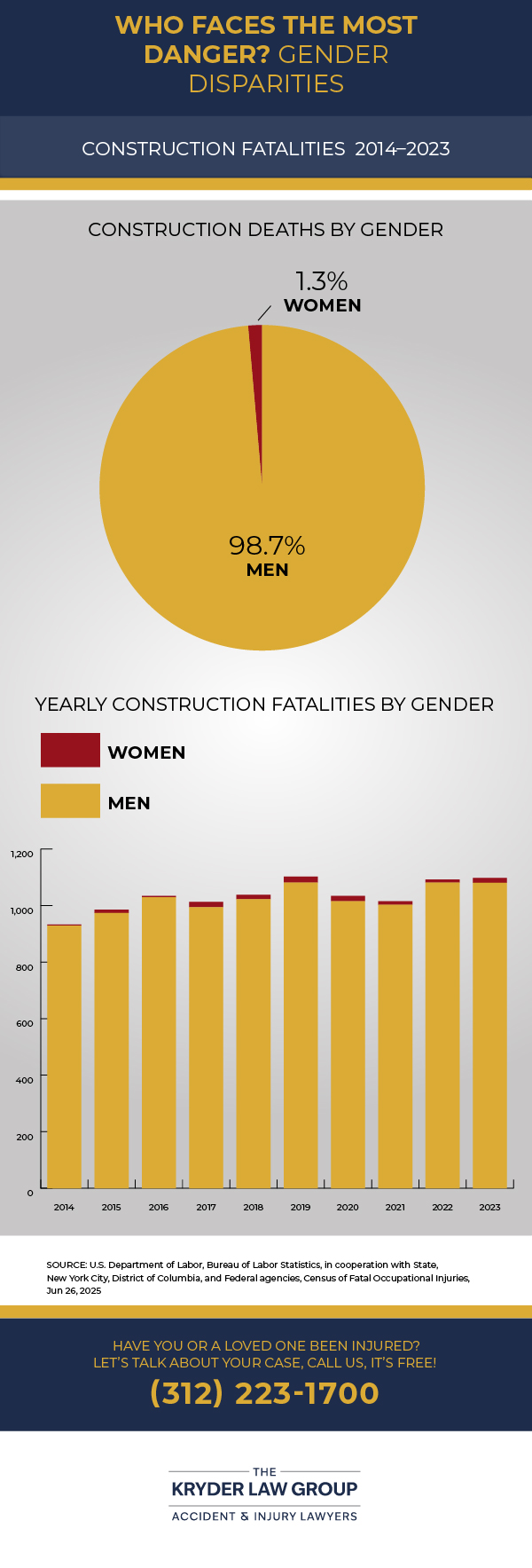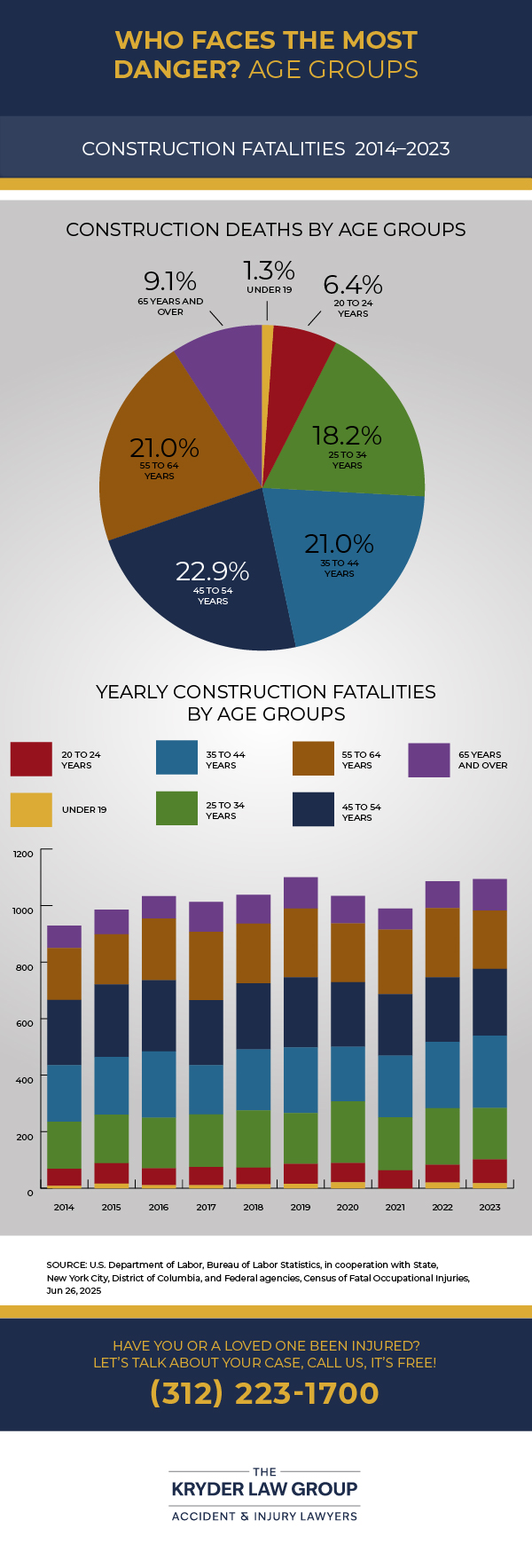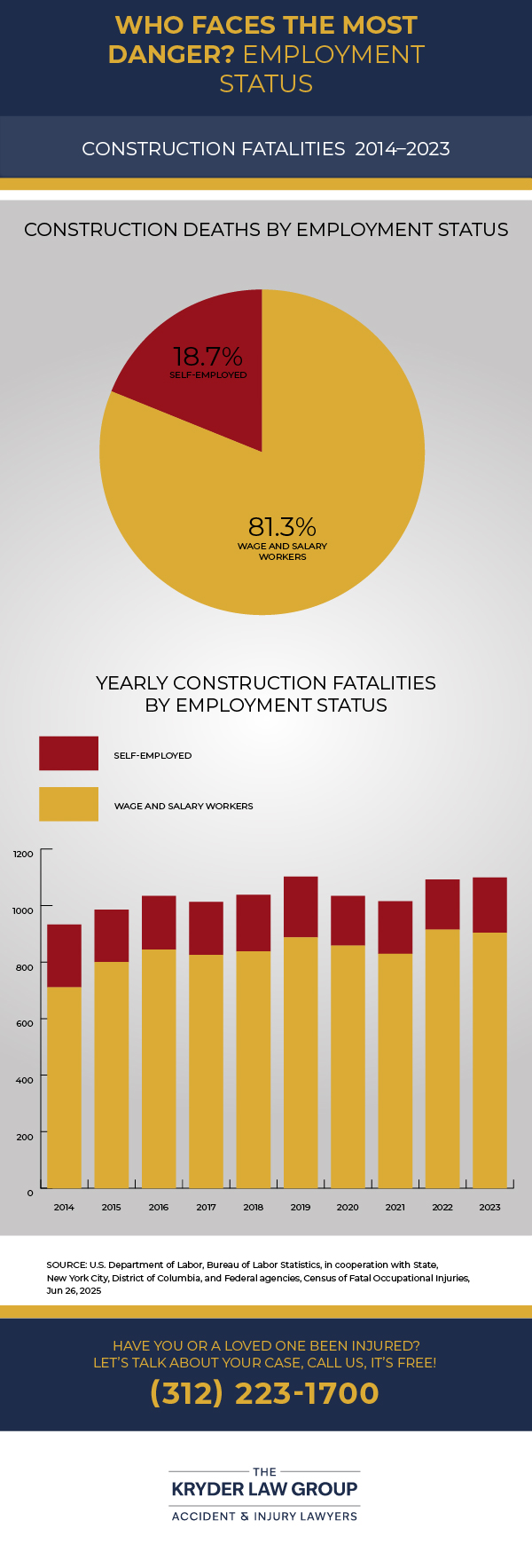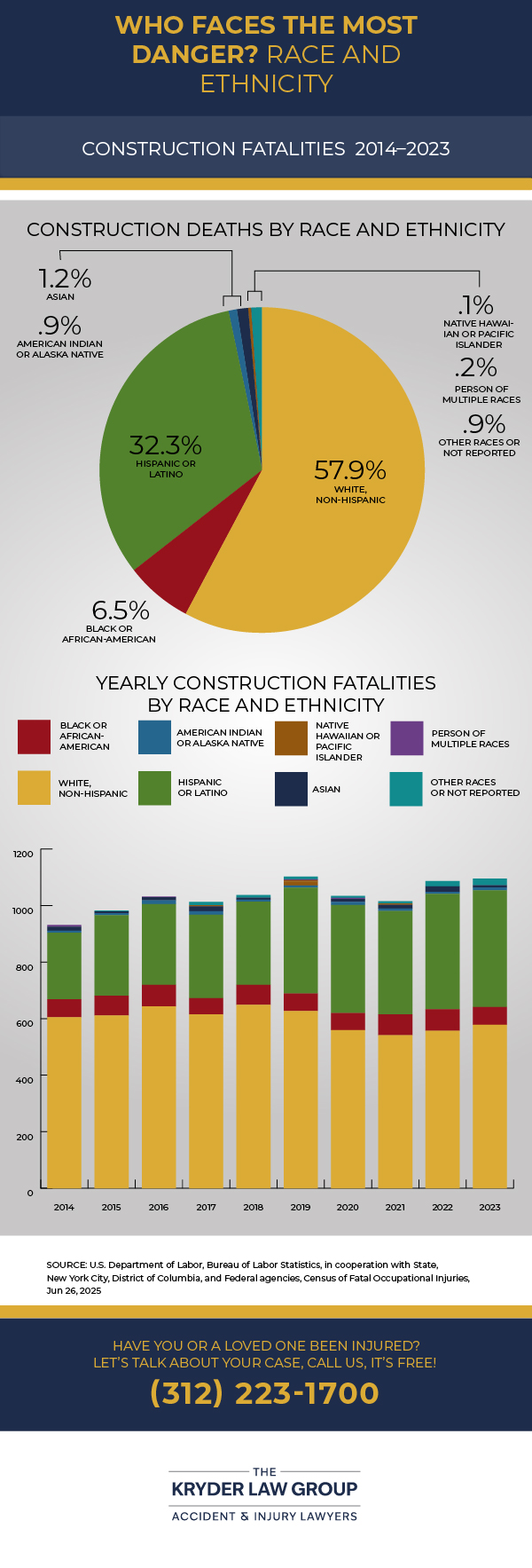Demographic Trends in Construction Accident Statistics
Construction remains one of America’s most dangerous industries. Over the past decade, thousands of workers have lost their lives on job sites across the country. Understanding who is most at risk can help prevent future tragedies and ensure workers get the protection they deserve.
This comprehensive analysis by our construction accident lawyers examines the demographics of fatal construction incidents from 2014 to 2023 to identify who is in the most danger. The numbers reveal concerning trends about worker safety and highlight which groups face the greatest risks. This analysis breaks down the demographics behind these workplace deaths and what they mean for construction safety moving forward.
The Overall Picture: 10,345 Lives Lost
Between 2014 and 2023, construction fatalities claimed 10,345 lives across the United States. These weren’t just statistics—they were fathers, mothers, sons, and daughters who went to work expecting to come home safely.
SOURCE: U.S. Department of Labor, Bureau of Labor Statistics, in cooperation with State, New York City, District of Columbia, and Federal agencies, Census of Fatal Occupational Injuries, Jun 26, 2025
Gender Disparities: Men Face Overwhelming Risk

The gender breakdown of construction fatalities reveals a stark reality. Of the 10,344 deaths recorded, men accounted for 10,208 fatalities—an overwhelming 98.7% of all construction deaths. Women represented just 136 fatalities, or 1.3% of the total.
This disparity reflects the male-dominated nature of construction work, where men make up the vast majority of workers in high-risk positions. While the percentage of female fatalities remained relatively low throughout the decade, the absolute numbers fluctuated significantly year to year. The highest single-year count for women occurred in 2019 with 21 deaths, while 2014 saw just 4 female fatalities.
These numbers underscore the importance of safety training and protective measures for all workers, regardless of gender. When accidents happen, the consequences can be devastating for any family.
Age Groups: Middle-Aged Workers Most Vulnerable

Age demographics reveal which workers face the highest risks on construction sites. Workers aged 45 to 54 experienced the most fatalities over the decade, accounting for 2,362 deaths or 22.9% of all construction fatalities. This group consistently showed high fatality rates throughout the 10-year period.
The second-highest risk groups were workers aged 35 to 44 and 55 to 64 with 2,163 deaths representing 21% of fatalities. Combined, these three groups accounted for nearly 65% of all construction deaths. Several factors may contribute to this pattern:
- These age groups often work in supervisory or high-skill positions that may involve greater exposure to hazards.
- Physical changes associated with aging may affect reaction times or physical capabilities.
- Years of work experience might lead to complacency about safety protocols.
Younger workers aged 25 to 34 accounted for 1,873 deaths (18.2%).
Older workers (65 and over) experienced 942 fatalities over the decade, representing 9.1% of deaths. While this percentage was lower than middle-aged groups, it highlights the risks faced by workers who continue in construction past traditional retirement age.
Young workers weren’t immune to danger. Those aged 20 to 24 experienced 664 fatalities (6.4%), while workers younger than 19 had 134 deaths (1.3%).
Employment Status: Wage Workers Bear the Burden

The employment status breakdown reveals important insights about who faces the greatest risks. Wage and salary workers accounted for 8,411 fatalities, representing 81.3% of all construction deaths. Self-employed workers experienced 1,934 fatalities, making up 18.7% of the total.
This distribution roughly mirrors the construction workforce composition, where most workers are employed by companies rather than working independently. However, both groups face serious safety challenges:
- Wage and salary workers may face pressure to complete jobs quickly or work in conditions they consider unsafe. They might also lack control over safety equipment and protocols on job sites.
- Self-employed workers often work alone or with minimal safety oversight. They may skip safety measures to save time or money and might not have access to the same safety training and equipment as larger companies provide.
Race and Ethnicity: Disproportionate Impact on Communities

The racial and ethnic breakdown of construction fatalities reveals troubling disparities. While White, non-Hispanic workers experienced the highest absolute number of deaths with 5,985 fatalities (57.9%). Latinx workers faced disproportionate risks.
Latinx workers accounted for 3,340 deaths, representing 32.3% of all fatalities. This percentage significantly exceeds the Latinx representation in the overall U.S. workforce, indicating elevated risks for this community. Several factors may contribute to this disparity:
- Language barriers that may prevent understanding of safety instructions
- Employment in higher-risk positions or with companies that have weaker safety programs
- Economic pressures that may discourage reporting unsafe conditions
- Immigration status concerns that might prevent workers from advocating for better safety measures
Black or African American, non-Hispanic workers experienced 672 fatalities (6.5%). Other racial and ethnic groups had smaller absolute numbers but still faced significant risks relative to their workforce representation.
What These Numbers Mean for Workers and Families
Behind every statistic lies a human story of loss and suffering. Construction fatalities don’t just affect the workers who lose their lives—they devastate families, friends, and entire communities. The financial impact can be crushing, as families lose primary income sources and face mounting medical and funeral expenses.
Workers who survive construction accidents often face long-term disabilities, chronic pain, and the inability to return to their previous jobs. The ripple effects extend throughout families and communities that depend on construction wages.
Understanding these demographics helps identify where safety improvements are most needed and which workers require additional protection and resources.
Moving Forward: Safety Must Be the Priority
The demographic breakdown of construction fatalities from 2014 to 2023 reveals clear patterns about who faces the greatest risks. Middle-aged workers, Latinx employees, and male workers all show elevated fatality rates that demand targeted safety interventions.
Construction companies, safety regulators, and workers themselves must use this information to improve protections for the most vulnerable groups. This includes better safety training, improved language accessibility for safety programs, and stronger enforcement of safety regulations.
When construction accidents happen, families need support navigating the legal and financial challenges that follow. Workers’ compensation, wrongful death claims, and personal injury cases can provide crucial financial resources, but the legal process can feel overwhelming during an already difficult time.
If you or your family has been affected by a construction accident, you don’t have to face the legal challenges alone. Our construction accident attorneys understand the complexities of workplace injury cases and can help you pursue the compensation you deserve. We work on a contingency fee basis, so you pay nothing unless we win your case.
The construction industry must do better to protect its workers. Until that happens, we’ll continue fighting for the rights of injured workers and their families, ensuring they receive full and fair compensation for their losses.











 (312) 223-1700
(312) 223-1700